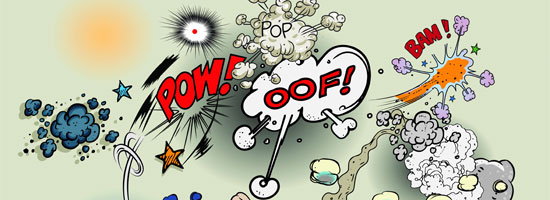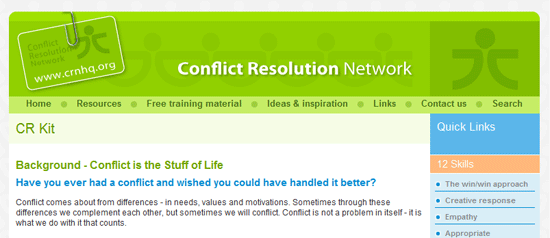- Home
- Blog
- Web Design When Creative Conflict is A Good Thing
When Creative Conflict is A Good Thing
-
 7 min. read
7 min. read
-
 William Craig
William Craig CEO & Co-Founder
CEO & Co-Founder
- President of WebFX. Bill has over 25 years of experience in the Internet marketing industry specializing in SEO, UX, information architecture, marketing automation and more. William’s background in scientific computing and education from Shippensburg and MIT provided the foundation for MarketingCloudFX and other key research and development projects at WebFX.
 During your career as a web professional, whether you’re a designer, developer or copywriter, you’re bound to encounter creative differences either within your team, or between you and a client. These situations can be emotionally taxing, but if you have a better understanding of how to work through them and even learn and grow from them, conflicts can actually make you better at your job. Here are some tips on getting the most out of your conflict, and when it’s best for everyone to just throw in the proverbial towel.
During your career as a web professional, whether you’re a designer, developer or copywriter, you’re bound to encounter creative differences either within your team, or between you and a client. These situations can be emotionally taxing, but if you have a better understanding of how to work through them and even learn and grow from them, conflicts can actually make you better at your job. Here are some tips on getting the most out of your conflict, and when it’s best for everyone to just throw in the proverbial towel.
Good Conflict/Bad Conflict
Conflict happens when two or more contradictory perspectives haven’t been agreed on, but it’s not necessarily a bad thing. In fact, when handled well, conflict forces us to be creative problem-solvers, to avoid mistakes, and to learn how to benefit from our differences, all while challenging us to broaden our skills. Conflict gets ugly when it affects workflow, gets personal, leads to more conflict, and harms working relationships.
Fortunately, there are things you can do to prevent disagreements from taking you down the wrong path, starting with learning about how different people deal with conflict.
Types of Conflict Behavior
Understanding the types of behavior that occur during conflict, and recognizing which apply to you and your peers, can help you discover how to get the most out of it. The types of conflict behavior are:
- Competing: you have a high concern for personal goals and low concern for relationships.
- Collaborative: you’re interested in a mutually satisfactory solution.
- Compromising: you’re willing to give something up if they are.
- Avoiding: you delay and ignore the conflict, hoping it will resolve itself.
- Accommodating: you’re willing to make a sacrifice to avoid confrontation.
Depending on the way you and your team deal with conflict with respect to the above behaviors, you could either find yourselves at a creative stand-still, or you could come out of the conflict better than if there was none at all. A study documented in Creativity and Innovation Management found that certain types of conflict behavior, specifically the confrontational variety, yield better results in terms of creative output. Researchers Petra Badke-Schaub, Gabriela Goldschmidt and Martijn Meyer observed video footage of design teams during idea generation.
They then compared the conflict behavior styles of each team to their creative output. The researchers found that high-scoring groups in the areas of innovation and functionality were more prone to competing and compromising, and low-rated groups were more collaborative. The findings also showed that more ideas were generated in the higher-scoring groups, while more repetition of ideas occurred in the low-scoring groups.
The researchers concluded that creative performance in teams is not achieved mainly by agreement, but needs cognitive confrontation. In other words, don’t be afraid to challenge the ideas of people on your team (respectfully), the results are often favorable, while being too agreeable for the purpose of avoiding confrontation can produce lackluster results.
Constructive Team Conflict
What’s the best way to deal with conflict on your team?
There are many methods out there, but perhaps the most applicable to conflict on a creative team, is the Conflict Resolution Network’s Creative Response kit.  One of the Network’s 12 conflict resolution skills, the Creative Response approach aims to shift the focus from the negativity of the conflict to the possibilities created by it. They suggest adopting an attitude of “discovery” rather than “perfection.” The perfectionist often approaches a conflicting creative idea with negative judgments, high emphasis on what is considered “right” and “wrong,” and a strong aversion to risk-taking due to the fear of making mistakes.
One of the Network’s 12 conflict resolution skills, the Creative Response approach aims to shift the focus from the negativity of the conflict to the possibilities created by it. They suggest adopting an attitude of “discovery” rather than “perfection.” The perfectionist often approaches a conflicting creative idea with negative judgments, high emphasis on what is considered “right” and “wrong,” and a strong aversion to risk-taking due to the fear of making mistakes.
This approach, argues the Network, produces winners and losers. The “discovery” approach sees conflict as an opportunity for learning and encourages exploration of ideas that may be met with opposition at first, but could lead to a new and better approach. Taking a discovery-type attitude in conflict involves taking more risks, experimenting, and creates winners and learners, rather than winners and losers.
This approach also encourages members of a team to take chances and become more motivated to present innovative ideas.
Client Conflicts
Even if you’re the best web designer, web developer, or web copywriter, chances are your clients aren’t always going to be pleased with your work. As a creative web professional, you may already be accustomed to the practice of not taking critical client feedback personally, but when the feedback gets unnecessarily abusive, you may want to re-evaluate whether the emotional casualties are worth the paycheck, or if you should decide to part ways.
One way to help prevent conflict from happening is to ensure that expectations are clearly communicated up front. If a client seems very easygoing at first, providing little or no direction to your project, be wary. Having creative freedom is usually a good thing, but lack of direction could also mean that your client isn’t aware of what they want, and intend to use you, and likely endless revisions, to figure it out.
Having a thorough preliminary research and interviewing process helps you get a clear understanding of the client’s wants and needs. Combining that with a clearly worded agreement that outlines everyone’s expectations and responsibilities gives you something to lean on should one party not hold up their end of the bargain. The agreement can also outline exact revision limits and what protocol to follow in the event of creative differences.
How to Part Ways Amicably
If many attempts to land on the same page have left you fruitless, or if you simply cannot take any further abuse from an unruly client (the client isn’t always right), you may decide that it’s best for everyone if you part ways. If they haven’t fired you already, firing your client is certainly not unheard of. How do you fire a client without tarnishing your name?
Taking an honest approach is always admirable. No matter how colorful your client may get with their language during conflict, you can be confident that you’re taking the high road by not reciprocating. If you’re comfortable enough to do so, simply inform them that you’ve done the best you can with what you’ve been given, and that perhaps your style is not in line with what they’re looking for.
Hopefully, if you’ve put in some work already, you’ll be able to salvage some of their deposit. If you don’t feel like the straight-up approach would turn out well for whatever reason, or if you’re just not comfortable with it, Freelance Switch has some creative ideas for firing your client:
- Hike your prices: If you announce that you are raising your prices, which is not uncommon, your client might decide to take their business elsewhere.
- Fill your schedule: Let the client know that your schedule is full for the time being and refer them to someone else (who is preferably more in line with the client’s style.)
- Stick to your guns: If all expectations have been communicated and the client is delinquent on any of the responsibilities on their end, simply stick to the agreement and don’t provide further work until requirements are met.
- It’s not you, it’s me: Let the client know that something in your personal life is preventing you from meeting their needs and that they should find an alternative.
- Just say no: When all else fails, refer back to good old, diplomatic honesty.
Moving Forward With a Positive Attitude
Every conflict, the good and bad, teaches us something about ourselves, about how we want to work, and who we want to work with. As you get more financially secure in your career, you’ll have an easier time picking and choosing the types of teams and clients you want to work with. Until then, approaching every conflict as an opportunity to learn, along with perhaps growing thicker skin, makes you a winner in the long run.
Related Content
- Feedback. The Creativity Killer.
- How to Design for Your Worst Client: You.
- Reminding Yourself That You Love What You Do
-
 President of WebFX. Bill has over 25 years of experience in the Internet marketing industry specializing in SEO, UX, information architecture, marketing automation and more. William’s background in scientific computing and education from Shippensburg and MIT provided the foundation for MarketingCloudFX and other key research and development projects at WebFX.
President of WebFX. Bill has over 25 years of experience in the Internet marketing industry specializing in SEO, UX, information architecture, marketing automation and more. William’s background in scientific computing and education from Shippensburg and MIT provided the foundation for MarketingCloudFX and other key research and development projects at WebFX. -

WebFX is a full-service marketing agency with 1,100+ client reviews and a 4.9-star rating on Clutch! Find out how our expert team and revenue-accelerating tech can drive results for you! Learn more
Make estimating web design costs easy
Website design costs can be tricky to nail down. Get an instant estimate for a custom web design with our free website design cost calculator!
Try Our Free Web Design Cost Calculator


Web Design Calculator
Use our free tool to get a free, instant quote in under 60 seconds.
View Web Design CalculatorMake estimating web design costs easy
Website design costs can be tricky to nail down. Get an instant estimate for a custom web design with our free website design cost calculator!
Try Our Free Web Design Cost Calculator




